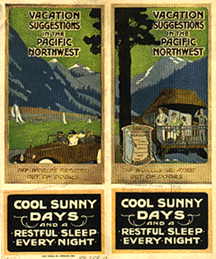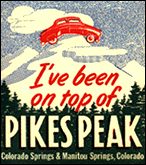August 1996

Brochure: Vacation Suggestions in the Pacific Northwest.
The World's Greatest Out of Doors.
Date: 1920 ID: 89.358.12
|
According to historian Daniel Boorstin in his book Images (1961), Americans are "probably the most traveled people of our time, or of any time." In their travels, Americans used descriptive literature, maps, pamphlets and guidebooks, many of which were saved as mementoes of pleasurable trips. The Travel Literature Collection at The Henry Ford represents materials provided by an American travel industry virtually born in the mid-19th century and grown to sophisticated maturity in the 20th.
Early 19th century travelers in the United States encountered rigorous conditions and modes of travel. They walked long distances, rode horseback, paddled canoes, endured jolting stagecoaches and slow sailing ships. Many overnight accomodations were unsanitary and, of necessity, shared with strangers. Private homes or inns provided lodging and food of often dubious quality, but offered the only respite available to travelers of the day.
|
| Many factors contributed to the growth of the travel industry including the advent of the railroads, which expanded from 3000 miles of track in 1840 to over 30,000 miles in 1860, providing the fastest form of transportation up to that time. Completion of the transcontinental railroad in 1869 opened the West to travelers, while railroad companies became strong promoters of vacation journeys. Additional comforts in trains such as Pullman and dining cars, electricity and heat further popularized this mode of travel through the end of the 19th century. In this opulent era, a private railroad coach became a mark of wealth well into the 1920s.
Affordable priced automobiles, improved highways, and paid vacations for increasing numbers of workers in the United States helped establish travel as a major activity for Americans by the middle of the 20th century. The family was free to choose destination and intinerary via super highways or quaint by-ways, traveling by automobile on 85% of their leisure trips after the 1930s. Families in all economic circumstances were able to enjoy scenic adventures in the West, educational jaunts to historic sites in the East, or perhaps camping trips to distant lakes. Organizations such as the Lincoln Highway Association and the Automobile Association of America sponsored route signs, maps and guidebooks which directed tourists to their destinations.
The museum's travel literature collection is gathered from many sources and covers the period from 1815 to the present. For more information, please contact the Research Center. |

Souvenir: I've been on top of Pike's Peak.
Object ID: 89.83.10
Date: ca. 1950s
|
[ Pic of the Month ] [ Pic Archive ]
|

